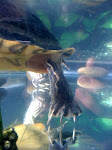Currently, in the Pacific Ocean there is floating island of garbage the size of Rhode Island. The island resides in the North Pacific Gyre, a swirling vortex ocean currents which remains relatively stationary about 1,000 miles west of Northern CA.
Plastic doesn't biodegrade, it photodegrades which basically means that photons, usually from the sun, break-up particles and irreversibly alter their atomic structure. The plastic pieces get smaller and smaller but don't ever disappear entirely. This happens in the salt water where the plastic begins to resemble zooplankton, the dominant life form in that part of the ocean. While it's floating in the water the plastic absorbs toxic chemicals like DDT and PCBs; the Jellyfish eat it and it becomes part of their living tissue. Jellyfish also get entagled in the web of bottles, nets, diapers and tupperware, their bodies often forming around nets and soda bottles
It's hard to imagine a place where plastic outnumbers biological organisms 6 to 1. When you think about all the plastic that gets deposited into the ocean, it's easy to understand how human beings across the globe have caused this island of trash to accumulate. While I'm sure Americans have contributed to a very large portion of the garbage patch, the currents deposit water from all over the world. Lost shipments containing thousands of plastic yellow ducks, cigarette lighters and sneakers have spilled over the years but approximately four fifths of the garbage is litter carried from waterways and drains. The gyre has been sucking up flotsam for centuries, but it wasn't until the advent of plastic that the sea trash stopped biodegrading.
The mass is so large that it's going to be impossible to remove. Where would we put all those billions of pounds of garbage? What if we were to rocket the island into space? What if it was to land in a neighboring solar system on a planet? What if the conditions were such that the protozoa and the plastic were to meld atomically, evolving into an entirely new organization of life? This idea perplexes me enormously... The other possibility is to round up the floating mass and tie it all together into a solid land form. Then people could build on it using the vast, recyclable resource of which the island is composed. Can we recycle the garbage patch and turn it into something positive and productive?
Friday, December 08, 2006
the garbage patch
Posted by
brinki dink
at
8.12.06
![]()
Subscribe to:
Post Comments (Atom)


2 comments:
where did you get this info, b? I'd like to read more.
hey girl,
here are some links to info re:the garbage patch. watch the cbs video, it's pretty interesting.
http://www.cbsnews.com/stories/2004/01/06/eveningnews/main591770.shtml
http://www.mindfully.org/Plastic/Ocean/Moore-Trashed-PacificNov03.htm
http://seattletimes.nwsource.com/html/pacificnw04232006/coverstory.html
Post a Comment